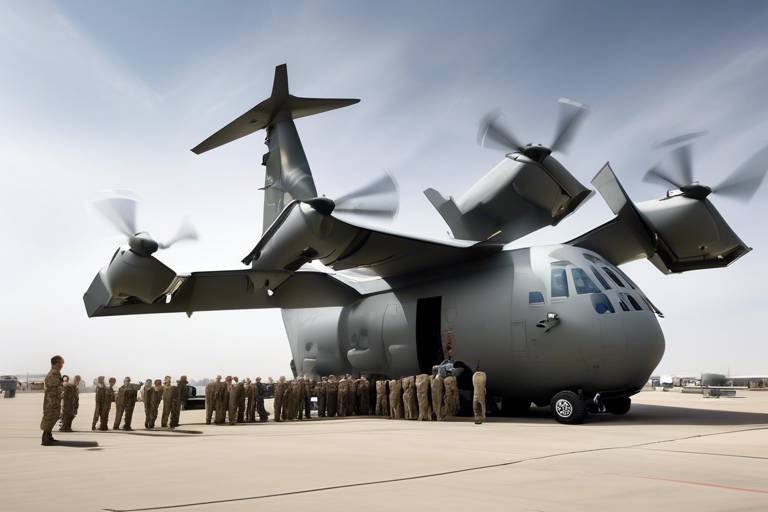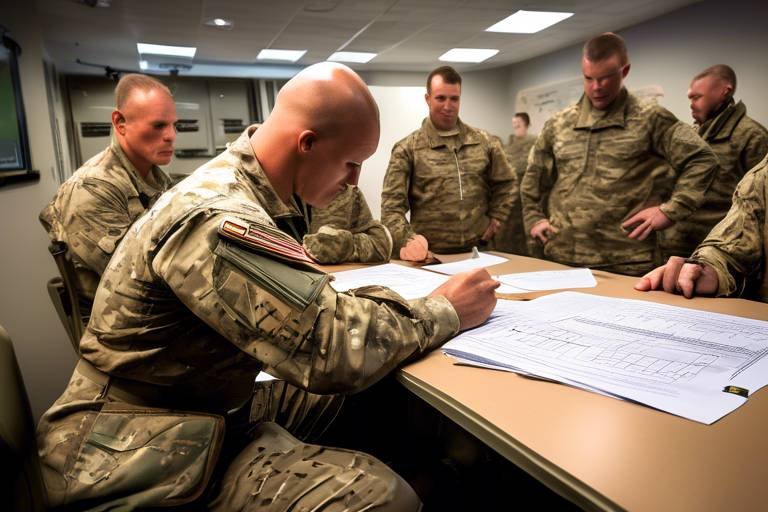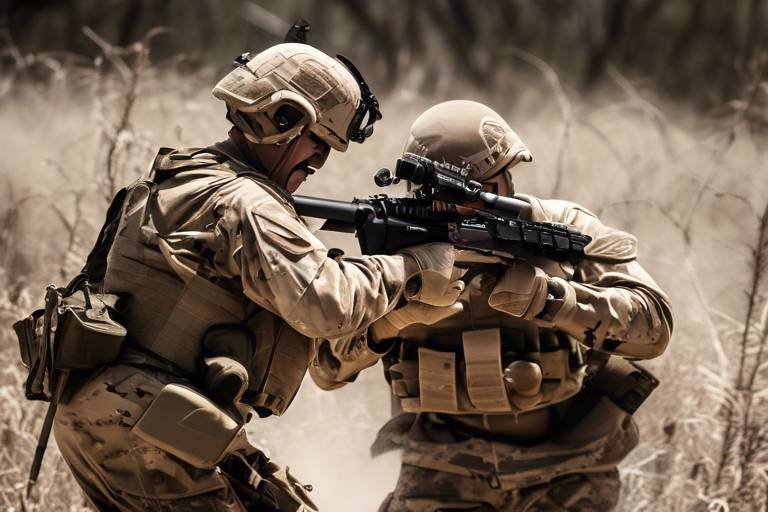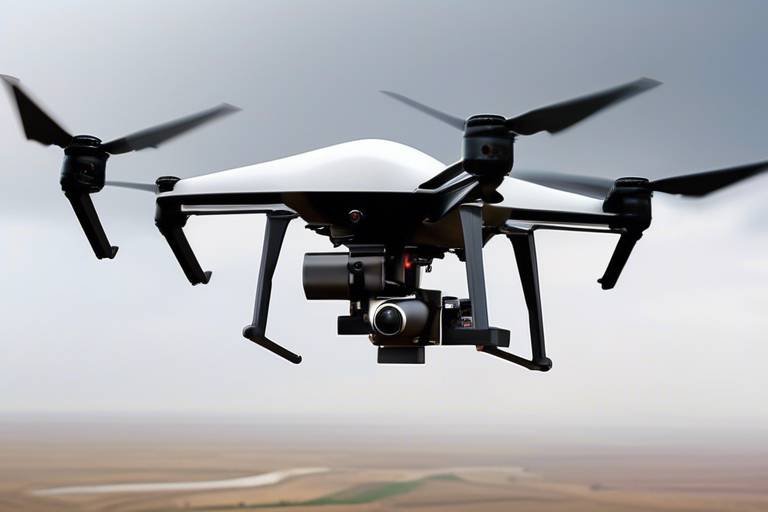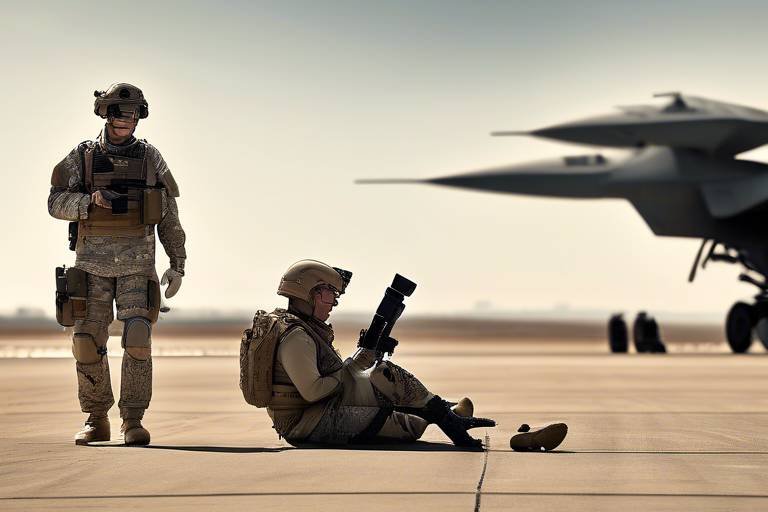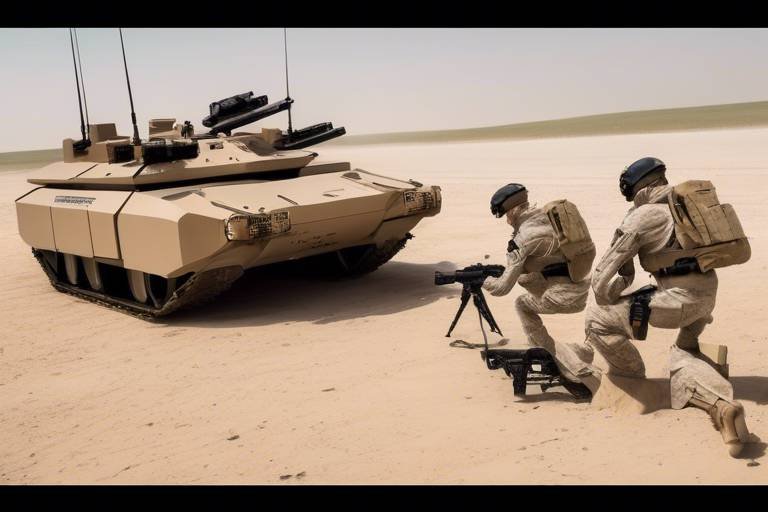Understanding the Benefits of Advanced Technology in Military Training
The modern battlefield is a complex and ever-evolving environment, and military training must keep pace with these changes. Advanced technology plays a crucial role in enhancing the effectiveness, efficiency, and overall readiness of military personnel. By integrating cutting-edge tools and methodologies, military organizations can prepare their forces for the challenges they face today and in the future. This article explores how these technological advancements are reshaping military training and why they are essential for maintaining a competitive edge.
One of the most significant advantages of advanced technology in military training is the ability to create realistic simulations. These simulations allow soldiers to engage in complex scenarios that mimic real-world conditions without the inherent risks of live exercises. Imagine a soldier navigating a high-stakes combat situation, making split-second decisions while under pressure, all within a controlled environment. This kind of training not only hones their decision-making skills but also fosters teamwork and communication among unit members. The ability to practice without real-world consequences is invaluable, as it prepares soldiers for the unpredictability of actual combat.
Advanced simulation technologies provide a platform for soldiers to engage in realistic training environments, allowing them to practice complex scenarios safely. These simulations improve decision-making skills and teamwork without the risks associated with live training exercises. With the help of sophisticated software and hardware, military training can now include scenarios that were previously deemed too dangerous or impractical to replicate. For instance, soldiers can practice urban warfare tactics in a virtual city, gaining experience without the logistical challenges of setting up a real-life training environment.
Virtual reality (VR) has emerged as a game-changer in military training, immersing soldiers in lifelike scenarios that enhance engagement and retention. Picture a soldier donning a VR headset, stepping into a simulated battlefield where they must navigate obstacles, communicate with their team, and respond to threats in real time. This immersive experience not only boosts their confidence but also prepares them for high-stress situations they may encounter during deployment. VR training can replicate various environments, from desert landscapes to dense urban areas, ensuring that soldiers are well-prepared for any situation.
Implementing VR technology can significantly reduce training costs by minimizing the need for physical resources. Traditional training often requires extensive equipment, travel, and personnel, which can strain budgets. However, with VR, the costs associated with physical setups are drastically reduced. This cost-effectiveness allows military organizations to conduct more frequent training sessions, ultimately leading to better-prepared troops. More training opportunities mean that soldiers can refine their skills continuously, rather than waiting for the next live exercise.
With VR, soldiers can complete training modules more quickly, allowing for faster skill acquisition. This efficiency helps military units maintain a higher state of readiness. Instead of spending hours on transportation and setup, soldiers can jump straight into their training, maximizing their time and resources. The streamlined process not only enhances learning but also ensures that troops can adapt to new tactics and technologies rapidly.
Another remarkable aspect of VR training systems is their ability to provide real-time feedback. Imagine a soldier completing a training module and receiving instant insights into their performance. This immediate assessment fosters continuous improvement and skill refinement. Soldiers can identify areas for growth and adjust their strategies accordingly, leading to a more competent and confident force. In the military, where every second counts, this feedback loop is invaluable for honing skills and improving readiness.
Artificial intelligence (AI) enhances training programs by personalizing learning experiences. AI can analyze individual performance and adapt training regimens to meet specific needs and skill levels. This means that no two training programs are identical; each soldier receives a tailored approach that maximizes their strengths and addresses their weaknesses. By leveraging AI, military organizations can ensure that every member of the force is receiving the most effective training possible, ultimately leading to a more capable and prepared military.
Utilizing data analytics in military training allows for the identification of trends and performance metrics. This data-driven approach enables commanders to make informed decisions regarding training strategies and resource allocation. By analyzing data collected from training exercises, military leaders can pinpoint areas where troops excel and where they may need additional focus. This insight is crucial for developing targeted training programs that align with the evolving needs of the battlefield.
Advanced monitoring systems track soldiers' progress over time, providing insights into strengths and weaknesses. This information is crucial for tailoring future training efforts effectively. By understanding individual performance metrics, military leaders can ensure that their training programs are not only comprehensive but also relevant to the current operational landscape. This personalized approach fosters a culture of continuous improvement, where soldiers are consistently challenged to grow and develop their skills.
Predictive analytics can forecast training requirements based on historical data. This proactive approach helps military organizations prepare for future challenges and allocate resources efficiently. By anticipating the skills needed for upcoming missions, commanders can ensure that their troops are always ready to face whatever comes their way. This forward-thinking strategy is essential in a world where threats are constantly evolving and adapting.
- What are the primary benefits of using advanced technology in military training? Advanced technology enhances realism, reduces costs, improves efficiency, and allows for personalized training experiences.
- How does virtual reality improve military training? Virtual reality immerses soldiers in lifelike scenarios, promoting engagement and preparing them for high-stress situations.
- Why is data-driven training important? Data-driven training allows military leaders to make informed decisions about training strategies and resource allocation, ensuring that troops are well-prepared.

Enhanced Simulation Techniques
This article explores how advanced technology enhances military training, improving efficiency, effectiveness, and readiness. We will discuss various technological advancements and their implications for modern military operations.
In the ever-evolving landscape of military training, have emerged as a game-changer. Imagine a training environment where soldiers can engage in complex scenarios without the inherent risks of live exercises. This is precisely what advanced simulation technologies offer. By creating realistic training environments, these technologies allow military personnel to practice decision-making and teamwork in a controlled setting, which is crucial for developing the skills needed in high-stakes situations.
One of the most significant advantages of these simulations is the ability to replicate various scenarios, from urban combat to humanitarian missions. This versatility ensures that soldiers can train for a wide range of potential situations they may face in the field. For instance, a soldier might find themselves in a tense hostage situation, where every second counts. Through simulation, they can practice their response, learn the best strategies, and understand the consequences of their actions without any real-world repercussions.
Moreover, the use of simulations fosters a culture of continuous learning. During these exercises, soldiers can receive immediate feedback on their performance, allowing them to make quick adjustments and improve their skills on the spot. This immediate assessment is invaluable as it cultivates a mindset geared towards constant improvement. The training is not just about going through the motions; it’s about mastering the art of decision-making under pressure.
Additionally, advanced simulations can be tailored to meet the specific needs of different units or individual soldiers. This customization ensures that each training session is relevant and impactful. For example, if a particular unit is preparing for a deployment in a specific region, the simulation can be adjusted to reflect the unique challenges they might encounter. This level of personalization is a significant leap forward compared to traditional training methods.
In summary, enhanced simulation techniques are revolutionizing military training by providing soldiers with the opportunity to practice in a safe, controlled environment that mimics real-life scenarios. With the ability to receive instant feedback and tailor training to individual needs, these technologies are not just improving training efficiency but are also crucial for ensuring that military personnel are ready for any challenge they may face in the field.
Virtual reality (VR) immerses soldiers in lifelike scenarios, enhancing engagement and retention. VR training can replicate high-stress situations, preparing troops for real-world challenges in a controlled setting.
Implementing VR technology can significantly reduce training costs by minimizing the need for physical resources. This cost-effectiveness allows for more frequent training sessions and better resource allocation.
With VR, soldiers can complete training modules more quickly, allowing for faster skill acquisition. This efficiency helps military units maintain a higher state of readiness.
VR training systems often include real-time feedback, enabling soldiers to understand their performance instantly. This immediate assessment fosters continuous improvement and skill refinement.
Artificial intelligence (AI) enhances training programs by personalizing learning experiences. AI can analyze individual performance and adapt training regimens to meet specific needs and skill levels.
Utilizing data analytics in military training allows for the identification of trends and performance metrics. This data-driven approach enables commanders to make informed decisions regarding training strategies and resource allocation.
Advanced monitoring systems track soldiers' progress over time, providing insights into strengths and weaknesses. This information is crucial for tailoring future training efforts effectively.
Predictive analytics can forecast training requirements based on historical data. This proactive approach helps military organizations prepare for future challenges and allocate resources efficiently.
- What are enhanced simulation techniques?
These are advanced training methods that create realistic environments for soldiers to practice complex scenarios safely. - How does virtual reality improve military training?
VR immerses soldiers in lifelike scenarios, enhancing engagement and preparing them for real-world challenges. - What role does artificial intelligence play in military training?
AI personalizes training experiences by analyzing performance and adapting training regimens to meet individual needs. - How can data analytics benefit military training?
Data analytics help identify trends and performance metrics, allowing for informed decisions regarding training strategies.

Virtual Reality in Training
Imagine stepping into a world where the boundaries of reality blur, where soldiers can engage in lifelike scenarios without the inherent risks of live training. Virtual Reality (VR) is revolutionizing military training by immersing personnel in environments that replicate real-world challenges. This technology not only enhances engagement but also significantly improves retention of critical skills. In a VR setting, soldiers can practice everything from tactical maneuvers to complex decision-making processes, all while experiencing the pressures of high-stress situations. The result? A more prepared and adaptable military force.
VR training environments are designed to be as realistic as possible. They can simulate various terrains, weather conditions, and even the sounds of battle, which allows troops to train under conditions they might face in the field. This level of realism is essential because it helps soldiers develop their instincts and reactions. When faced with a crisis, their training kicks in, allowing them to respond effectively. Think of it like a video game where players must navigate through challenges; the more they play, the better they get at anticipating and overcoming obstacles.
One of the standout features of VR training is its ability to provide immediate feedback. After completing a training module, soldiers can review their performance in real-time. This instant assessment is crucial for recognizing areas that need improvement and reinforces learning. For example, if a soldier makes a mistake during a simulated mission, they can analyze what went wrong and adjust their strategy on the spot. This iterative learning process is far superior to traditional training methods, where feedback may take days or weeks to receive.
Moreover, the cost-effectiveness of VR training cannot be overstated. Traditional military training often requires extensive resources—equipment, personnel, and sometimes even live ammunition. In contrast, VR training minimizes these costs significantly. By investing in VR technology, military organizations can allocate their budgets more efficiently, allowing for more frequent training sessions without the hefty price tag. This shift not only saves money but also maximizes training opportunities, ensuring that soldiers are consistently honing their skills.
Another remarkable advantage of VR training is its ability to reduce training time. With the immersive and engaging nature of VR, soldiers can complete training modules faster than ever before. This increased efficiency means that military units can maintain a heightened state of readiness, as troops are continually refining their skills without the lengthy downtime typically associated with traditional training. In essence, VR is like a turbocharger for military training—boosting speed and efficiency while enhancing overall performance.
As we look to the future of military training, the integration of VR technology is not just a trend; it's a paradigm shift. By combining the benefits of immersive environments with real-time feedback and cost-effectiveness, military organizations can create a training regimen that is not only effective but also engaging. As soldiers step into these virtual worlds, they are not just training—they are preparing to face the uncertainties of the battlefield with confidence and competence.

Cost-Effectiveness of VR Training
When we think about military training, the first thing that often comes to mind is the image of soldiers in the field, using real weapons and equipment, right? But what if I told you that Virtual Reality (VR) is revolutionizing this whole scenario? Yes, you heard that right! VR training is not just a futuristic concept; it's a practical solution that is proving to be incredibly cost-effective for military organizations around the globe.
One of the major advantages of implementing VR technology in military training is the significant reduction in costs associated with traditional training methods. Imagine the expenses involved in live exercises—fuel for vehicles, ammunition, maintenance of equipment, and even the logistics of transporting personnel to training sites. By switching to VR, many of these costs can be slashed dramatically. For instance, a recent study indicated that organizations could save up to 30% on training costs by utilizing VR simulations instead of conventional methods.
| Cost Factors | Traditional Training | VR Training |
|---|---|---|
| Ammunition | High | None |
| Equipment Maintenance | Ongoing | Minimal |
| Logistics | Complex | Simplified |
| Training Time | Long | Short |
Moreover, the ability to conduct more frequent training sessions without the hefty price tag is another perk of VR training. With traditional methods, logistical challenges often limit the number of training exercises that can be performed. However, with VR, soldiers can train whenever and wherever they need to, allowing for continuous skill enhancement. This flexibility not only saves money but also ensures that troops are consistently honing their abilities, which is crucial for maintaining readiness.
Additionally, VR training allows for better resource allocation. Since physical resources are minimized, funds can be redirected towards other essential areas, such as advanced equipment or technology upgrades. This means that military organizations can invest in cutting-edge technologies while still maintaining a robust training program.
In summary, the cost-effectiveness of VR training is evident in the way it reduces expenses, increases training frequency, and allows for better resource management. As military operations become more complex and demanding, the shift towards VR training not only makes financial sense but also enhances the overall effectiveness of military preparedness.

Reducing Training Time
In the fast-paced world of military operations, time is often of the essence. Traditional training methods can be time-consuming, requiring extensive resources and personnel to conduct live drills. However, with the advent of Virtual Reality (VR) technology, the landscape of military training is changing dramatically. VR allows soldiers to engage in immersive training sessions that can be completed in a fraction of the time it would take for conventional training methods. Imagine being able to simulate a complex battlefield scenario without the logistical nightmares of setting up a full-scale exercise. This is where VR shines.
One of the most exciting aspects of VR training is its ability to condense hours of training into shorter, more focused sessions. For instance, a typical live-fire exercise might take days to prepare and execute, while a VR equivalent can be set up and completed within hours. This not only saves time but also allows for more frequent training opportunities. Soldiers can repeat scenarios as often as needed, honing their skills and decision-making abilities without the constraints of time and space. As a result, they can achieve greater proficiency in their roles, which is crucial when every second counts in real-world situations.
Furthermore, VR training modules can be designed to target specific skills or scenarios that need improvement. Instead of a one-size-fits-all approach, soldiers can engage in tailored training that meets their unique needs. For example, if a unit struggles with urban combat tactics, they can dive into a VR simulation focused solely on that area. This targeted approach not only enhances learning but also accelerates the skill acquisition process. The ability to practice repeatedly in a controlled environment prepares soldiers to react instinctively when faced with high-pressure situations.
Moreover, the efficiency of VR training extends beyond just the time spent in the simulation. With the integration of real-time feedback mechanisms, soldiers can receive immediate insights into their performance. This instant feedback loop allows them to identify mistakes, understand their impact, and adjust their strategies on the fly. Instead of waiting for a debrief after a long training session, soldiers can learn and adapt in real-time, significantly reducing the overall time required to master complex skills.
In summary, VR technology is revolutionizing military training by drastically reducing the time needed for skill acquisition. By providing immersive, focused, and repeatable training experiences, it enables soldiers to become more proficient, more quickly. The combination of tailored training modules and real-time feedback creates a powerful learning environment that prepares military personnel for the challenges they will face in the field. As we continue to embrace these advancements, the military's overall readiness will undoubtedly improve, ensuring that our troops are always prepared for any situation.
- How does VR training differ from traditional training methods?
VR training offers immersive simulations that allow for repeated practice in a safe environment, while traditional methods often involve live exercises that can be time-consuming and resource-intensive. - Can VR training be customized for specific military needs?
Yes, VR training can be tailored to focus on particular skills or scenarios, making it a highly adaptable training tool for military personnel. - What are the cost implications of implementing VR training?
While initial setup costs may be high, VR training can lead to long-term savings by reducing the need for physical resources and allowing for more frequent training sessions.

Real-Time Feedback Mechanisms
In the fast-paced world of military training, have emerged as a game-changer. Imagine being in the heat of a training exercise, making split-second decisions, and having immediate insights into your performance. This is not just a fantasy; it’s the reality that advanced training technologies are bringing to our soldiers. With the integration of sophisticated software and hardware, trainers can now provide instant evaluations, allowing soldiers to adjust their tactics on the fly. This immediacy not only boosts confidence but also enhances learning outcomes.
Real-time feedback works by utilizing sensors and data analytics to track various performance metrics during training exercises. For instance, a soldier's reaction time, accuracy, and decision-making speed can all be monitored and analyzed in real-time. When a soldier completes a drill, they receive instant feedback, often displayed on a screen or through a wearable device. This information is crucial as it allows soldiers to identify areas needing improvement right away, rather than waiting for a debriefing session days later.
Moreover, the inclusion of interactive elements in feedback systems can significantly enhance engagement. For example, some training programs might use gamification techniques, where soldiers earn points or badges for achieving specific performance metrics. This not only makes training more enjoyable but also fosters a competitive spirit among troops, pushing them to strive for excellence.
To illustrate how real-time feedback works, consider the following table:
| Performance Metric | Feedback Type | Actionable Insight |
|---|---|---|
| Reaction Time | Instant visual cue | Adjust stance for quicker response |
| Accuracy | Score display | Focus on target acquisition |
| Decision-Making | Scenario analysis | Review alternative strategies |
This table highlights how different performance metrics can be assessed and how actionable insights are provided to soldiers immediately. The feedback is not just about what went wrong; it’s about offering a pathway to improvement.
Furthermore, the integration of real-time feedback mechanisms contributes to a culture of continuous improvement. Soldiers are encouraged to view feedback not as criticism but as a vital part of their growth. This shift in mindset is crucial in a military environment where adaptability and resilience are key. With each training session, soldiers can refine their skills, ensuring they are always prepared for the challenges ahead.
In conclusion, the implementation of real-time feedback mechanisms in military training represents a significant leap forward. By providing immediate insights and fostering a growth mindset, these technologies not only enhance individual performance but also elevate the overall effectiveness of military units. As we continue to embrace these advancements, the future of military training looks not only more efficient but also more engaging and effective.
- What are real-time feedback mechanisms? Real-time feedback mechanisms are systems that provide immediate performance evaluations during training exercises, allowing soldiers to adjust their tactics and improve skills on the spot.
- How does real-time feedback improve training outcomes? By offering instant insights, soldiers can identify areas for improvement right away, leading to faster skill acquisition and better overall performance.
- Can real-time feedback be used in other fields? Yes, real-time feedback mechanisms are also used in various fields, including sports, education, and corporate training, to enhance performance and learning.

Integration of Artificial Intelligence
Artificial Intelligence (AI) is revolutionizing the landscape of military training by personalizing learning experiences for soldiers. Imagine a training environment that adapts to each individual’s strengths and weaknesses, providing tailored instruction that enhances skill acquisition. This is not just a futuristic dream; it's happening now. AI systems can analyze vast amounts of data on a soldier's performance, identifying areas for improvement and adjusting training regimens accordingly. This level of customization ensures that every soldier receives the training they need to excel.
Furthermore, AI can simulate various combat scenarios, allowing soldiers to engage in realistic training exercises without the associated risks of live training. For instance, AI-driven simulations can create dynamic environments where the enemy's behavior changes based on the soldiers' actions, creating a more immersive and challenging experience. This kind of adaptability is crucial in preparing troops for the unpredictable nature of real-world operations.
One of the most significant advantages of integrating AI into military training is the ability to track performance metrics over time. AI systems can collect and analyze data from training exercises, providing commanders with insights into each soldier's progress. This data-driven approach allows military leaders to make informed decisions about training strategies and resource allocation, ensuring that every soldier is equipped with the skills necessary for success.
Moreover, AI can assist in predictive analytics, forecasting the training needs of military units based on historical performance data. For example, if data shows that certain skills are consistently lacking among troops, commanders can proactively adjust training programs to address those gaps. This foresight not only enhances the effectiveness of military training but also optimizes the use of resources.
In summary, the integration of Artificial Intelligence into military training is a game-changer. By providing personalized training experiences, enhancing simulation realism, and enabling data-driven decision-making, AI is helping to create more effective and prepared military personnel. The future of military training is not just about technology; it’s about harnessing the power of AI to ensure that our soldiers are ready for any challenge they may face.
- How does AI personalize military training?
AI analyzes individual soldier performance data to tailor training programs that address specific strengths and weaknesses. - What are the benefits of AI-driven simulations?
AI simulations provide realistic and dynamic training environments that adapt to soldiers' actions, enhancing preparedness without risks. - Can AI predict future training needs?
Yes, AI uses historical performance data to forecast training requirements, allowing military leaders to proactively adjust training strategies.

Data-Driven Training Approaches
In today's fast-paced military landscape, the integration of is not just a trend; it's a necessity. By harnessing the power of data analytics, military organizations can transform their training programs into highly efficient and tailored experiences. Imagine being able to pinpoint exactly where a soldier excels or where they struggle, and then adapting their training accordingly. This personalized approach not only enhances individual performance but also strengthens the overall capabilities of military units.
One of the key advantages of data-driven training is its ability to identify trends and performance metrics. Commanders can now analyze vast amounts of data collected from training exercises, simulations, and real-world operations. This analysis reveals patterns that were previously invisible, allowing for informed decision-making regarding training strategies. For instance, if data shows that a particular unit consistently struggles with urban warfare scenarios, commanders can allocate resources to focus on that area, ensuring comprehensive readiness.
Moreover, advanced performance monitoring systems play a crucial role in this data-driven approach. These systems track soldiers' progress over time, offering insights into their strengths and weaknesses. Imagine a coach who can see every player's performance metrics in real-time, adjusting training drills to target specific skills. This is what performance monitoring systems achieve in military training. They provide a continuous feedback loop that is essential for effective skill refinement.
Another exciting aspect of data-driven training is the use of predictive analytics. This powerful tool can forecast training needs based on historical data, which helps military organizations prepare for future challenges. For example, if past conflict data suggests an increase in cyber warfare, predictive analytics can highlight the need for enhanced training in that area. By anticipating future requirements, military units can allocate resources more efficiently, ensuring they are always one step ahead.
To illustrate the impact of data-driven training, consider the following table that summarizes the benefits:
| Benefit | Description |
|---|---|
| Enhanced Decision-Making | Data analytics provide commanders with insights to make informed training decisions. |
| Personalized Training | Training regimens can be tailored to individual soldiers' needs based on performance data. |
| Resource Allocation | Predictive analytics helps in efficiently distributing resources based on anticipated training needs. |
| Continuous Improvement | Real-time feedback fosters an environment of ongoing skill enhancement. |
In conclusion, the adoption of data-driven training approaches is revolutionizing military training. By leveraging data analytics, performance monitoring, and predictive analytics, military organizations can ensure that their training programs are not only effective but also adaptable to the ever-changing landscape of modern warfare. This proactive strategy ultimately leads to a more prepared and capable military force, ready to face any challenge that may arise.
- What are data-driven training approaches? Data-driven training approaches utilize data analytics to enhance military training by identifying trends, personalizing training, and improving resource allocation.
- How does predictive analytics benefit military training? Predictive analytics forecasts training needs based on historical data, allowing military organizations to prepare for future challenges effectively.
- What role do performance monitoring systems play? Performance monitoring systems track soldiers' progress and provide insights into their strengths and weaknesses, facilitating tailored training efforts.

Performance Monitoring Systems
In the realm of military training, have emerged as a game-changer, providing invaluable insights into the progress and capabilities of soldiers. These advanced systems are designed to track various metrics, offering a comprehensive overview of an individual's performance over time. Imagine being able to pinpoint not just where a soldier excels, but also where they struggle. This level of detail is crucial for tailoring future training efforts effectively. By analyzing data collected from simulations and real-world exercises, commanders can identify trends and make informed decisions that enhance overall readiness.
At the core of these monitoring systems are sophisticated algorithms that process vast amounts of data. They can assess everything from reaction times and decision-making abilities to teamwork and communication skills. This data-driven approach allows military leaders to create targeted training programs that focus on specific weaknesses, ensuring that every soldier receives the support they need to improve. For example, if a soldier consistently struggles with situational awareness during training exercises, the system flags this issue, prompting additional drills to enhance this critical skill.
Moreover, performance monitoring systems facilitate real-time feedback, which is essential for continuous improvement. Imagine a soldier in the midst of a training exercise receiving instant feedback on their performance. This immediate assessment not only boosts learning but also fosters a culture of accountability and self-improvement. Soldiers can review their actions, understand their mistakes, and adjust their strategies on the fly. This rapid feedback loop can significantly enhance skill acquisition and retention, making training sessions more effective.
To illustrate the effectiveness of performance monitoring systems, consider the following table that outlines key performance metrics tracked during training:
| Metric | Description | Importance |
|---|---|---|
| Reaction Time | Time taken to respond to a stimulus. | Critical for quick decision-making in combat scenarios. |
| Team Coordination | Effectiveness of communication and collaboration among team members. | Essential for successful missions that require teamwork. |
| Situational Awareness | Understanding of the environment and potential threats. | Key to making informed decisions under pressure. |
| Skill Proficiency | Level of expertise in specific tasks or operations. | Indicates readiness for real-world applications. |
As military operations evolve, so too must the methods used to train our soldiers. Performance monitoring systems not only enhance training efficacy but also ensure that military personnel are equipped with the skills necessary to face modern challenges. By leveraging data analytics and real-time feedback, these systems create a dynamic training environment where soldiers can thrive. The future of military training is undoubtedly data-driven, and performance monitoring is at the forefront of this transformation.
- What are performance monitoring systems?
Performance monitoring systems are advanced tools used to track and analyze soldiers' performance metrics during training exercises. - How do these systems improve military training?
They provide real-time feedback, identify strengths and weaknesses, and allow for tailored training programs that enhance skill acquisition. - Can performance monitoring systems predict future training needs?
Yes, by analyzing historical data, these systems can forecast training requirements, ensuring preparedness for upcoming challenges.

Predictive Analytics for Training Needs
Predictive analytics is revolutionizing the way military organizations approach training needs. By leveraging historical data and advanced algorithms, military leaders can forecast future training requirements with remarkable accuracy. Imagine having the ability to anticipate the skills your troops will need before they even step onto the battlefield. This is not just wishful thinking; it’s a reality that predictive analytics brings to the table.
At its core, predictive analytics involves analyzing patterns and trends from past training sessions, operational outcomes, and even external factors like geopolitical shifts. For example, if data shows that a certain unit consistently struggles with urban warfare scenarios, commanders can proactively implement targeted training programs to address these gaps. This approach not only enhances the overall readiness of the forces but also ensures that resources are allocated efficiently.
Moreover, the integration of predictive analytics allows for a more dynamic training schedule. Instead of a one-size-fits-all training plan, units can receive customized training regimens that adapt to their specific needs. This means that if a particular skill set is identified as lacking, additional training sessions can be arranged without disrupting the overall training timeline.
To illustrate the impact of predictive analytics, consider the following table that summarizes key benefits:
| Benefit | Description |
|---|---|
| Proactive Training | Identifying skill gaps before they become critical issues. |
| Resource Allocation | Optimizing training budgets and resources based on data-driven insights. |
| Customized Learning | Tailoring training programs to meet the unique needs of different units. |
| Informed Decision-Making | Empowering commanders with actionable insights for strategic planning. |
In addition to these benefits, predictive analytics fosters a culture of continuous improvement. As data is collected and analyzed over time, military organizations can refine their training strategies and methodologies. This iterative process not only enhances training effectiveness but also promotes a mindset of adaptability among troops. In a world where the nature of conflict is constantly evolving, being able to pivot and adjust training strategies is invaluable.
In conclusion, predictive analytics is not just a technological advancement; it’s a game-changer for military training. By harnessing the power of data, military leaders can ensure their forces are not only prepared for today’s challenges but also ready for tomorrow’s uncertainties. The future of military training lies in its ability to anticipate needs and adapt accordingly, and predictive analytics is at the forefront of this transformation.
- What is predictive analytics?
Predictive analytics involves using data, statistical algorithms, and machine learning techniques to identify the likelihood of future outcomes based on historical data. - How can predictive analytics improve military training?
By forecasting training needs based on past performance and trends, military organizations can tailor training programs to address specific skill gaps and optimize resource allocation. - Is predictive analytics cost-effective?
Yes, by identifying training needs efficiently, organizations can save costs associated with unnecessary training sessions and better allocate their budgets.
Frequently Asked Questions
- What are the main benefits of using advanced technology in military training?
Advanced technology enhances military training by providing realistic simulations, improving engagement through virtual reality, and allowing for personalized learning experiences using artificial intelligence. These benefits lead to better preparedness, reduced training costs, and more efficient skill acquisition.
- How does virtual reality improve military training?
Virtual reality immerses soldiers in lifelike scenarios that replicate high-stress situations. This immersive experience not only enhances engagement and retention but also allows troops to practice decision-making and teamwork in a safe environment without the risks associated with live exercises.
- Can virtual reality training really save costs?
Absolutely! Implementing VR technology can significantly reduce the need for physical resources, which lowers training costs. With VR, military units can conduct more frequent training sessions, allowing for better resource allocation and ultimately leading to a more prepared force.
- How does AI personalize military training?
Artificial intelligence analyzes individual performance and adapts training regimens to meet specific needs and skill levels. This personalized approach ensures that each soldier receives the training most beneficial for their growth, making the training process more effective and targeted.
- What role does data analytics play in military training?
Data analytics is crucial in identifying trends and performance metrics within military training. By utilizing this data-driven approach, commanders can make informed decisions regarding training strategies and effectively allocate resources to address specific needs.
- How are soldiers' performances monitored over time?
Advanced monitoring systems track soldiers' progress, providing insights into their strengths and weaknesses. This ongoing assessment is vital for tailoring future training efforts, ensuring that soldiers continue to develop their skills effectively.
- What is predictive analytics, and how does it benefit military training?
Predictive analytics uses historical data to forecast future training needs. This proactive approach helps military organizations prepare for upcoming challenges, ensuring that resources are allocated efficiently and that training remains relevant to evolving threats.



